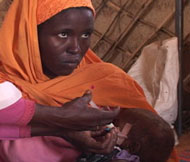 Build a U.S. Strategy for Responding to the Crisis in Sudan Build a U.S. Strategy for Responding to the Crisis in Sudan
Target Grade Levels:
Grades 7-12
Themes:
Conflict, Tyranny, and Renewal; U.S. Influence Abroad; Foreign Policy
• The Activity
• Relevant National Standards
• Cross-Curricular Activities
• Ties to Literature


The Activity


This activity will use a "jigsaw" strategy to help students explore aspects of the crisis in Sudan in 'expert' groups, and then return to their 'home' groups to develop recommendations for an appropriate U.S. response to the situation.
Start class with students seated in their 'home' groups.
Show students a map of the world. Point to Louisiana, Mississippi, and Alabama in the United States. Remind students that after Hurricane Katrina, hundreds of thousands of people evacuated. Texas reported taking in at least 230,000 people. The American Red Cross provided nearly 900 shelters across 27 states and the District of Colombia. The Bush Administration reported that in the first three weeks following Katrina, more than 500,000 evacuee families received emergency help to pay for food, clothing, and other essentials. Americans mobilized massive relief efforts to help those who had lost everything as a result of the storm.
Now point to Sudan in Eastern Africa. Explain that since 2003, violent conflict in the Darfur province in western Sudan � which has been called "genocide" by former Secretary of State Colin Powell � has left an estimated 50,000 to 80,000 dead and an estimated 1.2 million to 2 million people displaced. As in the U.S., some people forced out of their homes have chosen to live with friends, family or generous strangers rather than in camps set up by relief agencies. An estimated 200,000 Sudanese have escaped to Chad, where they are living in overwhelmed refugee camps that are unable to provide adequate assistance to the large numbers of those in need.
Ask students if the United States should respond differently to these two humanitarian crises. Why or why not? Allow a few minutes for students to share their ideas and justify their thinking.
Point out that helping a foreign country with its problems brings up a number of complex foreign policy issues. Students will explore some of these issues using Sudan as a case study.
Send students to their 'expert' groups to gather information. Have them take notes to justify how the U.S. should respond to the Sudan's needs for:
Humanitarian Aid
Group 1:
FRONTLINE/World: A Question of Genocide
pbs.org/frontlineworld/elections/chad.sudan/index.html
What improvements need to be made in the refugee camps?
What international organizations should the U.S. partner with?
What strategies has the U.S. tried so far?
Group 2:
U.S. strategy for international humanitarian response
www.state.gov/s/d/rm/rls/dosstrat/2004/23505.htm#hr
Does helping the Sudan support U.S. interests?
US AID report on assistance to the Sudan
www.usaid.gov/locations/sub-saharan_africa/sudan/
How much humanitarian assistance does the U.S. currently provide?
Political Stabilization
FRONTLINE/World: Facts & Stats on Sudan
pbs.org/frontlineworld/stories/sudan/facts.html
What challenges does the Sudan face in creating peace and a stable government?
What benefits would political stabilization bring to the economy?
International Intervention
Group 1:
FRONTLINE/World: A Question of Genocide
www.pbs.org/frontlineworld/elections/chad.sudan/index.html
FRONTLINE/World: Who's Who in Darfur?
pbs.org/frontlineworld/stories/sudan/relationshipsa.html
How is the international community helping/not helping in the Sudan?
Group 2:
FRONTLINE/World: A Question of Genocide
pbs.org/frontlineworld/elections/chad.sudan/index.html
FRONTLINE/World: Sudan Links and Resources
pbs.org/frontlineworld/stories/sudan/links.html
How would calling violence in Sudan "genocide" affect the U.S. and international response?
Have students return with their notes to their "home" groups and develop a group list of recommendations for an appropriate U.S. response to the situation in the Sudan. Circulate among the groups to ensure that students are considering a wide range of options, such as military intervention, diplomacy measures, lifting or imposing trade restrictions, supporting international relief efforts, etc.
Finally, have representatives from each "home" group share their lists with the class, field questions, and provide rationales for their thinking.
back to top


Relevant National Standards


These standards are drawn from "Content Knowledge," a compilation of content standards and benchmarks for K-12 curriculum by McRel (Mid-continent Research for Education and Learning) at http://www.mcrel.org/standards-benchmarks/.
Geography
Standard 9: Understands the nature, distribution
and migration of human populations on Earth's surface
Level IV, Benchmark 3: Knows how international migrations
are shaped by push and pull factors (e.g., political
conditions, economic incentives, religious values, family
ties)
Geography
Standard 13: Understands the forces of cooperation
and conflict that shape the divisions of Earth's surface.
Level IV, Benchmark 2: Knows the causes of boundary
conflicts and internal disputes between culture groups
(e.g., the conflict between North Korea and South Korea
, friction between the Spanish majority and Basque minority
in Spain , the civil war between the Hutus and the Tutsis
in Rwanda )
World History
Standard 44 : Understands the search for
community, stability, and peace in an interdependent world
Level III, Benchmark 4: Understands instances of political
conflict and terrorism in modern society
Level IV, Benchmark 10: Understands the effectiveness
of United Nations programs
back to top
|